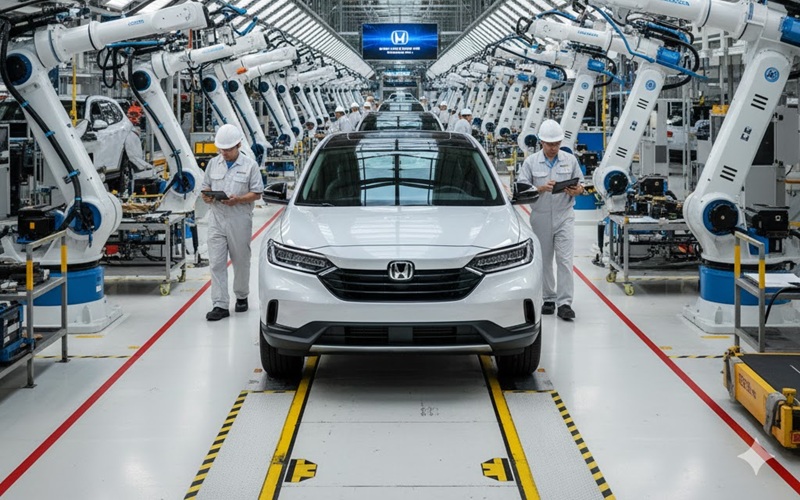Vehicle Stability Systems
In today’s fast-paced world, safety on the road is paramount. Vehicle stability systems are crucial in ensuring a safe and stable driving experience. Two such systems that have gained popularity are Honda Odyssey’s Vehicle Stability Assist (VSA) and Electronic Stability Control (ESC). These advanced technologies enhance vehicle stability and reduce the risk of accidents, especially in challenging driving conditions. This article deeply explores VSA and ESC, their differences, benefits, and how they work together in the Honda Odyssey.

Understanding Vehicle Stability Assist (VSA)
Vehicle Stability Assist, commonly known as VSA, is a cutting-edge safety feature developed by Honda. It is a comprehensive system that combines various components to improve stability and traction control. VSA constantly monitors the vehicle’s performance and employs corrective actions when necessary. The primary aim of VSA is to prevent oversteer or understeer situations, where the vehicle loses control during cornering or sudden maneuvers.
VSA utilizes sensors that measure wheel speed, steering angle, and lateral acceleration. If the system detects a potential loss of control, it selectively applies brakes to specific wheels and modulates engine power to regain stability. This seamless braking and engine management integration ensures that the vehicle remains on its intended path, even in challenging driving conditions.
Exploring Electronic Stability Control (ESC)
Electronic Stability Control, also known as ESC, is a safety feature that has become standard in most modern vehicles. ESC prevents skidding and loss of control by automatically applying brakes to individual wheels and adjusting engine power. It works with other vehicle systems, such as the anti-lock braking system (ABS) and traction control system (TCS), to provide a comprehensive stability control solution.
ESC uses sensors to monitor steering input, vehicle speed, and yaw rate. The system can detect and counteract potential instability by continuously analyzing these inputs. If ESC detects a skid or loss of control, it selectively applies brakes to specific wheels to help the driver regain control. Additionally, it can reduce engine power to prevent further loss of traction and stability. ESC is a crucial safety feature that significantly reduces the risk of accidents, especially in emergencies.
Differences Between VSA And ESC
While both VSA and ESC aim to enhance vehicle stability, there are some differences in their implementation and functionality. VSA, developed by Honda, is a proprietary system specific to Honda vehicles, including the Honda Odyssey. On the other hand, ESC is a more generic term that describes stability control systems across different automobile manufacturers.
One key difference lies in the sensors used by VSA and ESC. VSA utilizes sensors that measure lateral acceleration, while ESC incorporates additional sensors such as yaw rate sensors and steering angle sensors. These extra sensors provide ESC with a more comprehensive understanding of the vehicle’s dynamics, enabling it to intervene more effectively.
Another difference lies in the intervention methods employed by VSA and ESC. VSA primarily uses selective braking and engine power modulation to regain stability. In contrast, ESC applies brakes to specific wheels and can adjust engine power to a greater extent. This additional control over engine power allows ESC to have a more significant impact on stabilizing the vehicle.
Benefits of Vehicle Stability Assist
Vehicle Stability Assist (VSA) is a sophisticated safety feature that offers numerous benefits to drivers. First, it enhances overall vehicle stability, reducing the risk of accidents caused by oversteer or understeer situations. By selectively applying brakes and modulating engine power, VSA helps the driver maintain control and stay on their intended path.
Furthermore, VSA improves traction control, especially on slippery surfaces. The system detects wheel slip and intervenes promptly, ensuring maximum traction and minimizing the chances of skidding. This feature is particularly valuable in adverse weather conditions, where maintaining control can be challenging.
VSA also contributes to enhanced braking performance. By selectively applying brakes to specific wheels, VSA helps distribute braking force more effectively. This distribution of braking force reduces braking distances and improves overall braking stability, further enhancing safety on the road.
Benefits of Electronic Stability Control
Electronic Stability Control (ESC) is a standard safety feature in modern vehicles and offers a range of benefits to drivers. First and foremost, ESC enhances vehicle stability in various driving conditions. By intelligently applying brakes and adjusting engine power, ESC helps prevent skidding and loss of control, reducing the risk of accidents.
ESC also improves traction control, particularly on slippery surfaces. The system detects wheel slip and intervenes by selectively applying brakes and reducing engine power. This proactive approach ensures maximum traction, allowing the driver to maintain control even in challenging situations.
Furthermore, ESC helps in mitigating rollover accidents. The system can detect potential rollover conditions by monitoring factors such as vehicle speed, steering input, and yaw rate. In such instances, ESC intervenes by selectively applying brakes to specific wheels, effectively reducing the risk of rollover and ensuring the safety of the occupants.
Comparing VSA and ESC in the Honda Odyssey
The Honda Odyssey, a popular minivan known for its safety features, incorporates VSA and ESC to provide a comprehensive stability control system. Integrating these two technologies in the Honda Odyssey ensures enhanced stability, traction control, and safety.
VSA in the Honda Odyssey works seamlessly with the vehicle’s braking system and engine management. By selectively applying brakes and modulating engine power, VSA helps the driver maintain control during cornering, sudden maneuvers, or adverse driving conditions. This integration ensures the vehicle remains stable and on its intended path, providing a safe and comfortable driving experience.
ESC in the Honda Odyssey complements VSA by adding an extra layer of stability control. ESC enhances the vehicle’s stability in various driving scenarios using additional sensors and intervention methods. Whether it’s preventing skidding on slippery surfaces or mitigating rollover risks, ESC ensures that the Honda Odyssey always remains safe and stable.
How Vsa And Esc Work Together In The Honda Odyssey
VSA and ESC work harmoniously in the Honda Odyssey to provide optimal stability control. The integration of these two systems allows for a seamless exchange of information and coordinated intervention when necessary. By utilizing a combination of sensors and intervention methods, VSA and ESC work in tandem to enhance vehicle stability and reduce the risk of accidents.
When driving the Honda Odyssey, VSA continuously monitors various parameters, such as wheel speed, steering angle, and lateral acceleration. If VSA detects a potential loss of control, it intervenes by selectively applying brakes to specific wheels and adjusting engine power. At the same time, ESC analyzes inputs from additional sensors, such as yaw rate and steering angle sensors, to further enhance stability control.
If ESC detects a skid or loss of control, it can intervene by applying brakes to specific wheels and reducing engine power. This coordinated effort between VSA and ESC ensures that the Honda Odyssey remains stable and responsive in all driving conditions.
Honda Odyssey’s Safety Features And Technologies
Apart from VSA and ESC, the Honda Odyssey boasts a range of other safety features and technologies. These additional features further enhance the vehicle’s overall safety and provide peace of mind to drivers and passengers alike.
One notable safety feature is the Honda Sensing suite, which includes technologies such as collision mitigation braking system, road departure mitigation system, and adaptive cruise control. These advanced systems utilize radar sensors and cameras to detect potential hazards and assist the driver in avoiding accidents.
Furthermore, the Honda Odyssey incorporates an advanced airbag system, which includes front, side, and curtain airbags. These airbags provide a cushioning effect in the event of a collision, minimizing the risk of injuries to occupants.
A Safe And Comfortable Driving Experience
In conclusion, vehicle stability systems such as Vehicle Stability Assist (VSA) and Electronic Stability Control (ESC) play a vital role in enhancing safety on the road. The Honda Odyssey, with its integration of VSA and ESC, provides a comprehensive stability control system that ensures optimal stability, traction control, and overall safety. By constantly monitoring various parameters and employing selective braking and engine power modulation, VSA and ESC work together to keep the Honda Odyssey stable and responsive in all driving conditions. Coupled with other safety features and technologies, the Honda Odyssey sets a high standard for safety in the minivan segment. Whether navigating sharp corners or driving on slippery surfaces, the Honda Odyssey provides a safe and comfortable driving experience for the driver and passengers.
A Closer Look at the Honda Civic 2001-2005 Hybrid Engine
Satellite GPS for Your Honda Civic: Enhancing Navigation




